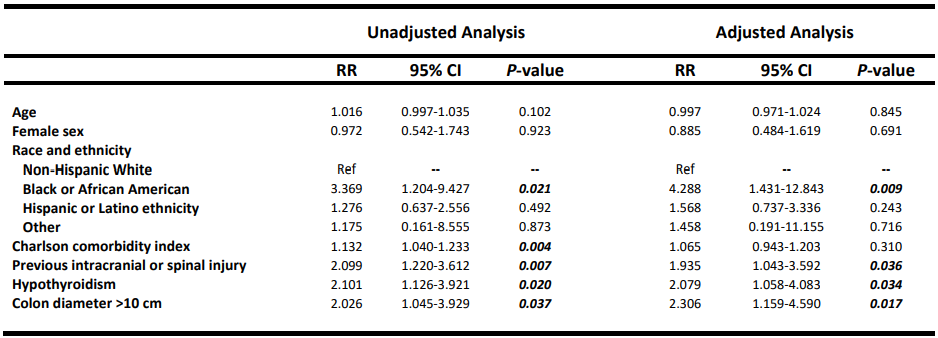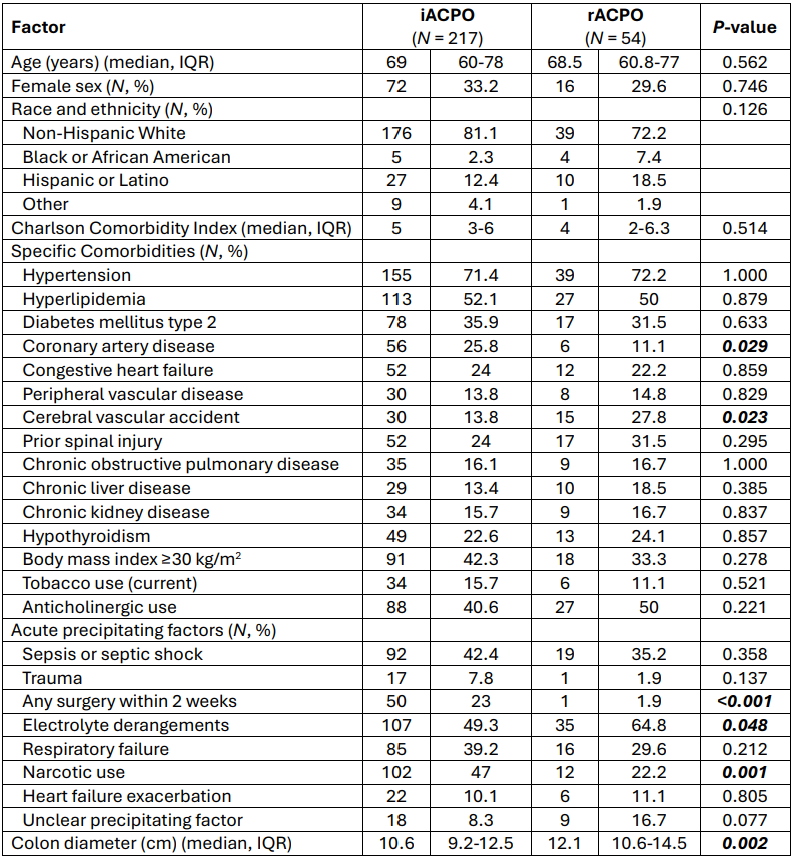Sunday Poster Session
Category: Colon
P0274 - Recurrent Acute Colonic Pseudo-Obstruction Is Common and Associated With African American Race and Increased Colonic Dilation at First Episode

Joseph Gunderson, MD
University of Texas Southwestern Medical Center
Dallas, TX
Presenting Author(s)
1University of Texas Southwestern Medical Center, Dallas, TX; 2University of Arizona College of Medicine, Tucson, AZ; 3Banner - University of Arizona Tucson, Tucson, AZ; 4University of Arizona, Tucson, AZ
Introduction:
Acute colonic pseudo-obstruction (ACPO) is a rare condition involving massive colonic dilation without mechanical obstruction, typically affecting critically ill or post-operative patients. Although established treatments exist, recurrent ACPO (rACPO) poses a significant challenge, yet data on its risk factors are limited. This study aimed to characterize and identify risk factors for rACPO.
Methods:
We conducted a retrospective analysis of patients ≥18 years old with ACPO, identified using ICD-9/10 codes from January 2014 to June 2024 across 1,238 Banner Health sites. Data collected included demographics, clinical factors, and dates of ACPO onset, resolution, recurrence, and most recent contact. The primary outcome was the development of rACPO. Fisher’s exact test and the Mann-Whitney U test assessed differences between initial ACPO (iACPO) and rACPO cases. Adjusted Poisson regression assessed risk factors for rACPO with an offset accounting for differing observation times.
Results:
271 ACPO cases in 217 patients (median age 69 years, 33.2% female, 81.1% non-Hispanic White) were identified with 42 (19.4%) having at least one rACPO during the study period (median observation time 1,224.5 days). Of all cases, 54 (19.9%) were rACPO with 33 patients having 1, 6 patients having 2, and 3 patients having 3 recurrences. The median time to any recurrence was 136 days (IQR 30.5-337.5), and was 136 (IQR 32-477.25), 30 (IQR 20-278), and 348 (IQR 193-657) for first, second, and third, respectively.
Compared to iACPO, rACPO cases were more associated with electrolyte derangements (64.8% vs. 49.3%, P = 0.048) and had a higher median colon diameter (12.8 vs. 10.6 cm, P = 0.002). iACPO cases were more often precipitated by surgery (23% vs. 1.9%, P < 0.001), and narcotic use (47% vs. 22.2%, P = 0.001). No clear precipitating factor was found in 8.3% and 16.7% of iACPO and rACPO cases, respectively.
rACPO risk factors included colon diameter >10 cm during iACPO (aRR 2.31, P = 0.017), hypothyroidism (aRR 2.08, P = 0.034), prior intracranial or spinal injury (aRR 1.94, P = 0.036), and African American race (aRR 4.29, P = 0.009).
Discussion:
One in five ACPO cases were found to be recurrent. rACPO is associated with electrolyte disturbances and less often by postoperative status and narcotic use. rACPO risk factors include African American race, prior intracranial or spinal injury, hypothyroidism, and colon diameter >10 cm during the iACPO episode.
Figure: Table 1. Baseline characteristics among initial (iACPO) and recurrent acute colonic pseudo-obstruction (rACPO) cases
Figure: Table 2. Poisson regression assessing risk factors for recurrent acute colonic pseudo-obstruction
Disclosures:
Joseph Gunderson indicated no relevant financial relationships.
Fariba Hossain indicated no relevant financial relationships.
Alisia Gunderson indicated no relevant financial relationships.
David Schaub indicated no relevant financial relationships.
Chiu-Hsieh Hsu indicated no relevant financial relationships.
Sasha Taleban: AbbVie – Grant/Research Support. Boehringer-Ingelheim – Grant/Research Support. Eli Lilly – Grant/Research Support. Janssen – Advisory Committee/Board Member, Grant/Research Support. Pfizer – Grant/Research Support. Takeda – Grant/Research Support.
Joseph Gunderson, MD1, Fariba Hossain, BS2, Alisia C. Gunderson, MD1, David J. Schaub, MD3, Chiu-Hsieh Hsu, PhD4, Sasha Taleban, MD, FACG2. P0274 - Recurrent Acute Colonic Pseudo-Obstruction Is Common and Associated With African American Race and Increased Colonic Dilation at First Episode, ACG 2025 Annual Scientific Meeting Abstracts. Phoenix, AZ: American College of Gastroenterology.

